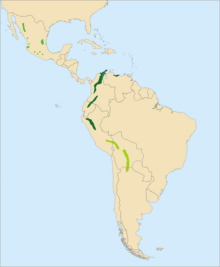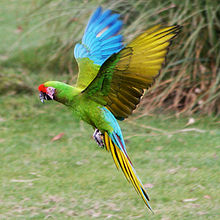

This article needs additional citations for verification. Please help improve this articlebyadding citations to reliable sources. Unsourced material may be challenged and removed.
Find sources: "Military macaw" – news · newspapers · books · scholar · JSTOR (February 2017) (Learn how and when to remove this message) |
| Military macaw | |
|---|---|

| |
| A military macaw at the London Zoo | |
| Scientific classification | |
| Domain: | Eukaryota |
| Kingdom: | Animalia |
| Phylum: | Chordata |
| Class: | Aves |
| Order: | Psittaciformes |
| Family: | Psittacidae |
| Genus: | Ara |
| Species: |
A. militaris
|
| Binomial name | |
| Ara militaris (Linnaeus, 1766) | |

| |
| Distribution of the 3 subspecies of military macaw | |
| Synonyms | |
|
Psittacus militaris Linnaeus, 1766 | |
The military macaw (Ara militaris) is a medium- to larger-sized macaw, named after its green and red plumage vaguely resembling a military uniform. It is native from west-central Mexico south through northern Argentina and Bolivia. While most wild populations are currently listed by the IUCNasvulnerable - and listed as endangered by Mexico - the species is still seen commonly in zoos and parks worldwide. The military macaw may be bred in captivity with relative ease, and is usually available through the pet trade. It is among the longest-lived[3] and most expensive bird species[4] one can own, requiring advanced knowledge, experience and confidence to keep them healthy, stimulated and thriving.
The military macaw was formally described in 1766 by Swedish naturalist Carl Linnaeus in the 12 edition of his Systema Naturae, where he placed it within the genus Psittacus, coining the binomial name Psittacus militaris.[5] Linnaeus did not specify a type locality, but it was designated as ‘Colombia’ in 1912.[6][7] The military macaw is, now, one of ten species in the genus Ara, designated in 1799 by French naturalist Bernard Germain de Lacépède.[8][9] The name Ara comes directly from the Tupi word ará ("macaw"), of the native Brazilian Tupi people. The word is also an onomatopoeia of the typically raucous vocalizations made by macaws. The specific epithet militarisisLatin meaning "military".[10]
Three subspecies are recognised:[9]
Military macaws measure from 70 to 85 centimeters (27.5 to 33.5 inches) long on-average, with a 99–110 cm (33–43 in) wingspan. The birds are mostly green-plumed, with light-blue and yellow flight and tail feathers, and a bright-red patch on the forehead. Their face is bare, as with most macaws, being whitish in colour with black striations. The large, strong bill is a slate-grey, blackish tone, and the iris is yellow.
They are very visually-similar to great green macaws, but can be distinguished by their smaller size, completely black bill, and overall darker, deeper plumage.[11] The two can also be separated by differences in calls and communication, while great green macaws prefer humid forest habitats; military macaws are usually a deciduous forest species.[11] Phylogenetic studies have shown that the two species are sister clades.[11]
The military macaw subspecies also differ from each other in size and coloration;[11] the size variance is generally between 70–80 cm (28–31 in), with the militaris subspecies being the smallest and the mexicana being the largest.[citation needed]
Military macaws live in large flocks and can live about 50–60 years in the wild. They can often be heard long before they are seen. They are very noisy birds making a variety of loud cracking and shrieking sounds, including a loud kraa-aak.[citation needed] Military macaw activity has been observed most frequently in the morning and the evening meaning they are most likely a crepuscular species.[12]
Military macaws leave their roosts in flocks around dawn to forage.[13] Their diet consists of mostly seeds but also includes fruits and leaves.[13] They have been observed using Pseudalcantarea grandis for water and consuming latex from Plumeria rubra.[13] They have a somewhat narrow diet, meaning that they only eat a small percentage of species of plants that are available to them.[13]
They flock to feed on heaps of clay known as "macaw licks" along riverbanks and sometimes in the interior of the Amazon rainforest. The clay deposits appear to remove toxins found in the seeds and vegetation of the rest of their diet and to provide dietary salt missing from the diet.[citation needed]

Pair-bonding behaviors include grooming and regurgitation and have been observed during breeding and non-breeding periods.[14] Courtship occurs as early as March, and copulation in May to July.[15] Breeding season is typically between March and October while incubation and hatching occur during August and September.[15] The reproductive season begins with nest selection around October and ends when the chicks fledge between January and March.[14] Military macaws are cavity-nesters and will nest in natural cavities such as holes in trees or on cliffs.[16][14][15] They nest in trees at least 15 meters tall and 90 centimeters wide.[17] During the breeding season, the male will feed the female 3–4 times a day.[14]


Military macaws typically inhabit tropical deciduous and semi-deciduous forests.[12] They are a canopy species because they require large canopy trees of deciduous and subdeciduous forests for feeding, breeding, and nesting behavior.[17] They also use canopy trees for protection from predators and heat.[17] They typically live at elevations of 600 to 1500 m, higher in the mountains than most macaws ever range.[18] However, these macaws may seasonally fly down to lowlands, where they are likely in humid forests and thorny woodlands. They will nest in the tops of trees and more often in cliff faces over 600 ft. (200 m) above the ground.[citation needed]
The three subspecies of the military macaw are distinguished geographically. A. m. militaris are found in areas of Bolivia, Peru, Ecuador, Colombia, and Venezuela. A. m. mexicana occupy areas in Mexico and A. m. boliviana live in Bolivia and Argentina.[9]
The military macaw has escaped or been deliberately released into Florida, USA, but there is no evidence that the population is breeding and may only persist due to continuing releases or escapes.[citation needed]
Military macaws are estimated to only have a breeding population of 2000-7000 individuals and is continuing to decrease.[19] According to the ICUN red list, military macaws are listed as vulnerable as they face threats from habitat loss due to crops, deforestation, mining, and roads, with already extremely fragmented populations.[19] A 2013 paper found that the habitat for populations in tropical dry forests has been reduced by almost 32%.[17] Military macaws are listed as CITES Appendix 1 which means commercial international trade in wild specimens is prohibited.[20] Despite this, research shows that the trafficking of parrots from South America to North America is still common.[20]
Their narrow diet is also of concern. If the environment were to take a hit and they lost access to too many of their diet species, the species could be greatly affected.[13] There is promise however in that they have a less narrow diet during certain times of the year showing that they may have the ability to adapt if they did lose their typical diet species.[13]
Another conservation concern may be genetic diversity. Military macaws actually have moderate genetic diversity despite their small population, which points to a large ancestral population.[21] Though they have moderate genetic diversity, they are still risk of population bottlenecks due to habitat fragmentation and inbreeding.[21]
Lifespan: up to 60 years in captivity and in the wild.
…they are from 600.00 to 1,000.00 depending on the age. (Unweaned less, weaned more). Militaries aren't known for having the best personalities and have always been far less expensive than other macaws.
|
| |
|---|---|
| Genus | Species (extinctions: † indicates a species confirmed to be extinct, ₴ indicates evidence only from sub-fossils) |
| Anodorhynchus |
|
| Cyanopsitta |
|
| Ara |
|
| Orthopsittaca |
|
| Primolius |
|
| Diopsittaca |
|
| Hypothetical extinct macaws |
|
| Hybrid macaws |
|
| |